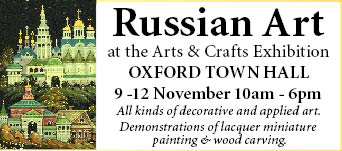For the second year running, Russian artists are exhibiting their work at Oxford Town Hall, as part of a major art and craft exhibition which includes both local and international artists. The most prolific – and most striking – part of the exhibit is miniature lacquer work, but there are also wood carvings, batik paintings, landscapes, tempera paintings, hand crafted bowls, Christmas decorations made of birch bark and of course a marvellous selection of matrioshka – the Russian dolls within dolls. There is one large and extremely beautiful icon of the Mother of God, but generally this is a secular exhibition. All items are for sale, at prices ranging from a few pounds to thousands. Many of them are of museum quality, and potential collector’s items.
This exhibition is a joint venture by Ludmilla Fishchuk, Russia’s leading authority on its art – particularly the miniature painting on lacquer boxes – and the Friends of Kholui, whose purpose is to support the Art School in the village of Kholui. During the week there will be demonstrations of lacquer miniature painting by Zhenya Grachev, President of Union of Master Artists, and of wood carving by Mikhail Dvornikov. It will be possible to discuss commissions.
Misha Dvornikov’s carvings are utterly charming. Now in his early fifties, he was first attracted to working with wood at the age of eight, and so a lifetime of experience goes into his work. It is in the traditional Russian folk genre – including bears who can be made to type on their computer keyboards, or play the piano. In a small 3-D nativity scene, Mary rocks the cradle of the Christ-child.
The really outstanding part of the exhibition, however, is the collection of lacquer miniatures. These come from the four villages in Russia which traditionally produce them, and it is interesting to compare the different styles. One, for example, developed its tradition through the influence of German snuff boxes, and the images are quite westernised. The other three villages were originally known for icon painting, and turned to subjects of landscape and folk tale when they were no longer allowed to produce religious art after the 1917-18 Revolution. Ironically, their livelihoods are once more threatened with the collapse of communism, since State funding has now been withdrawn.
The artistry of these miniatures is quite extraordinary, and it is worth taking time to study them with the magnifying glasses provided. There is a huge variety of styles and subjects, most of them extremely colourful: looking at them is like entering into a fairytale landscape. Besides the more traditional work there are some highly original images. In particular, Evgeniy Grachev specialises in lacquer work in sepia tones, and one of the most beautiful boxes had a miniature painting of his grandmother’s house which was like a very detailed sepia photograph, complete with washing hung out, chickens and a bicycle.
The exhibition is on just until Saturday. Whether you wish to make an investment, buy a Christmas present, or simply spend an hour in another world, it is well worth a visit.
This exhibition is a joint venture by Ludmilla Fishchuk, Russia’s leading authority on its art – particularly the miniature painting on lacquer boxes – and the Friends of Kholui, whose purpose is to support the Art School in the village of Kholui. During the week there will be demonstrations of lacquer miniature painting by Zhenya Grachev, President of Union of Master Artists, and of wood carving by Mikhail Dvornikov. It will be possible to discuss commissions.
Misha Dvornikov’s carvings are utterly charming. Now in his early fifties, he was first attracted to working with wood at the age of eight, and so a lifetime of experience goes into his work. It is in the traditional Russian folk genre – including bears who can be made to type on their computer keyboards, or play the piano. In a small 3-D nativity scene, Mary rocks the cradle of the Christ-child.
The really outstanding part of the exhibition, however, is the collection of lacquer miniatures. These come from the four villages in Russia which traditionally produce them, and it is interesting to compare the different styles. One, for example, developed its tradition through the influence of German snuff boxes, and the images are quite westernised. The other three villages were originally known for icon painting, and turned to subjects of landscape and folk tale when they were no longer allowed to produce religious art after the 1917-18 Revolution. Ironically, their livelihoods are once more threatened with the collapse of communism, since State funding has now been withdrawn.
The artistry of these miniatures is quite extraordinary, and it is worth taking time to study them with the magnifying glasses provided. There is a huge variety of styles and subjects, most of them extremely colourful: looking at them is like entering into a fairytale landscape. Besides the more traditional work there are some highly original images. In particular, Evgeniy Grachev specialises in lacquer work in sepia tones, and one of the most beautiful boxes had a miniature painting of his grandmother’s house which was like a very detailed sepia photograph, complete with washing hung out, chickens and a bicycle.
The exhibition is on just until Saturday. Whether you wish to make an investment, buy a Christmas present, or simply spend an hour in another world, it is well worth a visit.





